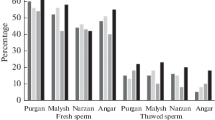Summary
The sensitivity and specificity of a zinc spot test for the detection of semen were compared with those of an acid phosphatase detection method. As screening techniques both tests were found to be very sensitive, but the zinc test was more specific and was more reliable in older and especially in deteriorated specimens. It is concluded that the zinc spot test deserves at least the same place as the acid phosphatase test in the primary investigation of suspected semen stains and might well be the test of choice in older and poorly preserved stains.
Zusammenfassung
Sensitivität und Spezifität eines Fleckentests zum Sper-manachweis auf der Basis der Zinkkonzentration im Samen wurden mit den genannten Gütekriterien der sauren Phosphatasetechnik verglichen. Beide Tests waren als Suchtests geeignet, aber der Zinktest erwies sich als spezifi-scher und zuverlässiger für ältere und denaturierte Proben. Demnach kommt dem Zinktest als Sperma-Suchtest zumindest derselbe Stellenwert zu, wie der Phosphatase-Methode. Bei alten und schlecht erhaltenen Spuren sollte dem Zinktest der Vorzug gegeben werden.
Similar content being viewed by others
References
Brown K, Brown C (1974) Specificity of two commercial acid phosphatase determination kits with respect to feminine hygiene products and vaginal contraceptives. J Forensic Sci 19: 384–289
Eliasson R, Lindholmer C (1971) Zinc in human seminal plasma. Andrologia 3:147–153
Fisher R (1949) Acid phosphatase tests as evidence of rape. N Engl J Med 240:738–739
Gaensslen RF (1983) Sourcebook in forensic serology, immunology and biochemistry. National Institute of Justice, U. S. Department of Justice, Washington D.C.
Gomez R, Wunsh C, David J, Hicks D (1974) Qualitative and quantitative determinations of acid phosphatase activity in vaginal washings. Am J Clin Pathol 64:423–432
Hansen P (1946) Determination of the prostatic acid phosphatase as a new method for medico-legal demonstration of sperm spots. Acta Pathol Microbiol Scand 23:187–214
Hauck G, Leithoff H (1959) Die Phosphatasebestimmung als gerichtsmedizinischer Sperma-nachweis. D Z Gesamte Gerichtl Med 49:5–20
Hazen C (1955) Measurements of acid phosphatase activity to identify seminal stains. J Crim Law Criminol Police Sci 46:408–413
Kaye S (1949) Acid phosphatase test for identification of seminal stains. J Lab Clin Med 34: 728–732
Kind S (1958) Stable test papers for seminal acid phosphatase. Nature 182:1372–1373
Kind S (1964) The acid phosphatase test. In: Curry A (ed) Methods of forensic science, vol III. Interscience, New York, pp 267–288
Kutscher W, Wohlbergs H (1935) Prostataphosphatase. Hoppe-Seyler's Z Physiol Chem 236: 237–240
Lundquist F (1946) Function of prostatic phosphatase. Nature 158:710–711
Lundquist F (1950) Medicolegal identification of seminal stains using the acid phosphatase test. Arch Pathol 50:395–399
Mawson C, Fischer M (1953) The occurrence of zinc in the human prostate gland. Can J Med Sci 30:336
McCloskey K, Muscillo G, Noordewier B (1975) Prostatic acid phosphatase activity in the postcoital vagina. J Forensic Sci 20:630–636
Rasmussen M (1945) Un nouveau principe pour le diagnostic des taches de sperme sur les étoffes. Ann Med Leg Criminol Police Sci 25:110–117
Riisfeldt O (1946) Acid phosphatase employed as a new method of demonstrating seminal spots in forensic medicine. Acta Pathol Microbiol Scand Suppl 58:80
Sensabaugh G (1979) The quantitative acid phosphatase test. A statistical analysis of endog-enous and postcoital acid phosphatase levels in the vagina. J Forensic Sci 24:346–365
Sniff A (1978) Reliability of the acid phosphatase test for the identification of seminal fluid. J Forensic Sci 23:833–844
Suzuki O, Asano M, Kido A, Oya M (1983) Zinc test as a new tool for identification of human seminal stains. Forensic Sci Int 22:231–235
Tamaki K, Fujisawa K, Okajima H, Sato K, Katsumata Y (1989) Identification of semen in stains by determination of the specific activity ofl-tartrate-inhibitable acid phosphatase. Z Rechtsmed 102:429–436
Walker (1950) A new test for seminal stains. N Engl J Med 242:110–111
Walther G (1967) Die Beeinflussung des Spermanachweises durch einige moderne Waschmittel. Arch Kriminol 140:163–172
Walther G, Höhn P (1971) Aktivitätsbestimmungen der sauren Phosphatase in verschiedenen biologischen Medien unter Verwendung vono-Carboxyphenylphosphat. Z Rechtsmed 69:259–262
Author information
Authors and Affiliations
Rights and permissions
About this article
Cite this article
Hooft, P., van de Voorde, H. Comparative study of the sensitivity and specificity of the zinc and acid phosphatase spot tests for the detection of seminal stains. Z Rechtsmed 103, 581–586 (1990). https://doi.org/10.1007/BF01261422
Received:
Issue Date:
DOI: https://doi.org/10.1007/BF01261422



